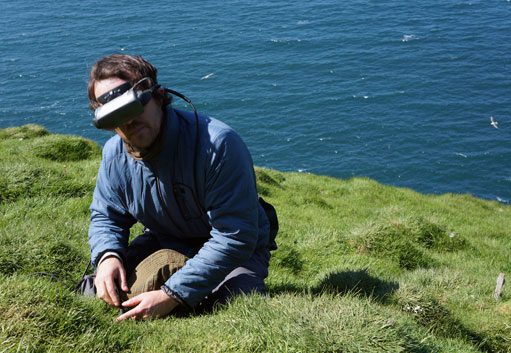Peek Into a Puffin Burrow in Iceland [sounds and video]
By Hugh Powell June 26, 2012

Puffins are great to watch in the sun—but how to watch them in their burrows? 

Most puffin colonies require a boat ride to an offshore island. 

At Vigur Island, hundreds of Black Guillemots greeted us on the beach. 

Locals collect eiderdown from nests on Vigur after the birds leave. 

To see into puffin burrows, Nick Richardson dons video goggles. 

Researchers Erpur Hansen and Nick Richardson probe burrows with a camera. 

The video goggles reveal a grainy image of a puffin and an egg.
Studying puffins in Iceland, where the birds are numerous but also vulnerable to changes in climate and oceans, is important work—but it doesn’t always look like it. Researchers like Erpur Hansen who want to know how the breeding season is going have to figure out how to look inside puffin nests dug into the ground. It’s not as convenient as raising the lid on a bluebird box or pulling back some twigs to peer in at a cardinal. Fortunately, Hansen has technology: a “burrow cam.”
It’s a miniature camera on a long, flexible cable, connected to a set of video goggles that lets Hansen see what the camera sees. Wearing the gray plastic device he looks rather like Geordi LaForge, the blind engineer in Star Trek: The Next Generation—and he has to be careful when he moves around, because although the goggles let him see through the camera, he can’t see directly in front of him.
It’s also quite difficult to thread the camera four feet or more into the burrow and keep it pointed in the right direction, so Hansen and his assistant, Nick Richardson, spend a lot of time lying face down in the grass, their arms stuck into burrow entrances, with hoods pulled over their heads to cut the sun’s glare on the goggles. If you didn’t know what they were doing, you might think they were looking for a contact lens or perhaps coping with a severe headache.
But wearing the goggles is something else entirely. When I put them on it was suddenly as if I was actually in the burrow. I kept moving my head around to try and see around corners—until I remembered I needed to move the camera instead. As the camera advanced slowly along the burrow (lit with infrared lights that the puffins can’t see), I felt as if I were exploring a cave, brushing past hanging roots, tiptoeing around rocks, and trying to remember which way was up as the view rotated away from the horizontal.
I had to keep the camera pointed toward the darkest part of the image—that’s the empty interior of the burrow. Usually, a pale shape would pop into view, which my mind would quickly rearrange into parts of a puffin: the white breast and curving black throat; the pale cheek, dark eyestripes, and even an eye, blinking at me; the big bill with its curving grooves marking the age of the puffin; and sometimes a smooth egg tucked under one wing.
The video screens in the goggles are very small, so they don’t record very well. But I tried anyway, using my iPhone, so that you could get an idea of what burrow-camming is like. It’s not as good as wearing the goggles yourself, but watch this video and see how soon you can make out the puffin at the end of the burrow, and its egg:
The video doesn’t include sound, but seabird colonies are noisy places. Here are a couple of examples:
Listen to the strange, amusing whoops of Common Eiders on a quiet day at Vigur Island (with Arctic Terns, Black Guillemots, and Meadow Pipits):
Listen to the hubbub of Northern Fulmars, Black-legged Kittiwakes, and tens of thousands of puffins, Common Murres, Thick-billed Murres, and Razorbills at Drangey Island:
(Images by Hugh Powell. Check out the full puffin story in Living Bird magazine.)


All About Birds is a free resource
Available for everyone,
funded by donors like you






